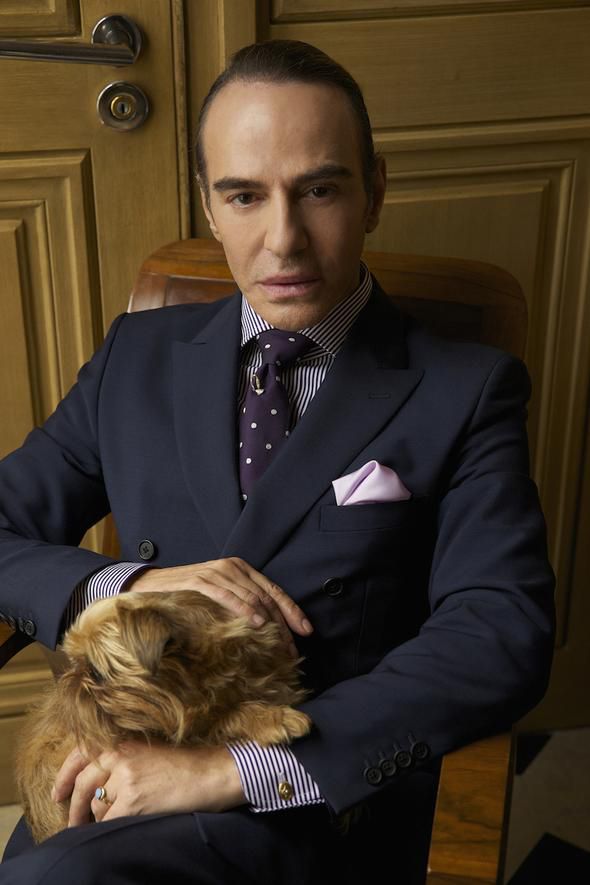When John Galliano staged Maison Margiela’s Artisanal collection on January 25th, 2024, it felt less like a runway and more like a film come to life. Critics, models, and attendees alike found themselves located in a rainy, Belle Époque-tinted drive under Paris’ iconic Pont Alexandre III as the show opened with French singer Lucky Love, accompanied by a gospel choir, performing his song ‘Masculinity’ before a short film directed by Sasha Kasihua melted into the runway itself. Every element of the show, from the staged “underbelly” of a 1920s Paris to the uncanny porcelain-like faces of the models, announced an unmistakable return to extreme theatricality in fashion. The show predictably became the past couture season’s most talked-about event, and a year on, its influence is still visible across today’s fashion landscape.
Galliano’s Artisanal line read more like a layered narrative rather than a jumbled series of discrete looks. The creative director borrowed Margiela’s canon —deconstruction, visible seams, and signs of decay —and blended it with his own obsession with exaggerated silhouettes, storytelling, and historical pastiche, drawing influences from Brassaï and Kees van Dongen. There were sheer, china doll-inspired faces paired with corsetry and tiered latex, trench coats refashioned into dresses, and unnatural hip volumes that alternately hid and revealed the body. The result felt like a collaboration between costume, couture, and film: garments that were at once accomplished technical feats and dramatic characters in their own right. Reviews called the production “astonishing” and “a celebration of individuality and craft.”
Behind all the revered garments were intensive techniques, like Pat McGrath’s “glass skin” makeup that required seven layers of misted-on product and craft details that referenced Margiela’s history of reinvention and Galliano’s talent for reshaping the human silhouette. The models, or rather Galliano’s “muses,” were all cast as archetypes in the story depicted on the runway. Some of the most notable examples of this were Gwendoline Christie as the “porcelain doll” and Leon Dame as the “street phantom.” The clothes served to complete the stories of each character that were articulated down the runway, rather than to simply drape over them. Photographs captured the show’s eerie light and cinematic staging, but the interactive experience of watching it live, many critics claim, was what made it unforgettable.
Experts and the public reacted to the collection with a mix of rapture and debate. Fashion press praised the show for returning Haute Couture to a place of theatrical risk, saying that the house had “managed to meld old-school craft and high tech” and produced one of the modern era’s most-talked about presentations. On the other end, social media had turned the runway into a sensation overnight. Everyone, from acclaimed style critics to casual viewers, had relished in the feeling that shows pre-social media had once invoked.

At the same time, the show reopened old conversations regarding Galliano’s past controversies and about how the fashion world reconciles talent with accountability. By the end of 2024, Galliano departed from Maison Margiela after a decade of creative direction at the house, something that journalists connected with both his career arc and the intense cultural scrutiny surrounding high-profile designers.
To understand why this collection has resonated beyond runway headlines, a spotlight belongs on the garments themselves. Galliano used classic couture methods, as hand-sewn structures and intricate draping, but he also incorporated Margiela’s philosophy of making the invisible visible to the human eye. Linings became surfaces, inner boning was reimagined as sculptural detail, and the reconstruction of the predictable became a form of narrative. The clothes suggested histories: a dress might look as though it had been lived in for decades, with its patina and patching part of the design. This mixed vocabulary, of ruin and refinement, of theatricality and technical precision, gave the collection a sense of resilience. It was not simply a spectacle for spectacle’s sake; the looks contained design ideas that could be translated into ready-to-wear, editorial styling, and even commercial echoes.
Over a year and a half after the show, that resilience continues to show in several visible ways. First, editorial and street styling have noticeably embraced the “deconstructed glamour” look: unexpected layering, exposed inner seams, and deliberately distressed finishes appearing in editorials and on fast-fashion street tables alike. Second, makeup and beauty trends have picked up on the “glass skin” illusion popularized by McGrath’s work at the show, applying it to commercial beauty shoots and influencer tutorials. Finally, runway production itself seemed to take cues from Galliano’s influence. Now, more designers are staging narrative-driven shows that blend performance, film, and set design rather than relying on the minimalist catwalk that has overtaken the last decade. Critics credited the Margiela show with reminding the industry that couture can be a cultural event, not merely a product launch.
Additionally, industry voices noted a halo effect for Margiela (and by extension, for Galliano’s approach) in brand visibility and sales growth metrics discussed throughout 2023-2024. The designer’s departure in December of 2024 also prompted commentary on succession and legacy at the house, which serves as further proof that the show’s ripples reached beyond aesthetics and into business and brand identity.
A single show rarely overturns an entire industry. But Galliano’s 2024 Artisanal collection performed an important function: it reminded the fashion world that risk, narrative, and technical mastery have the ability to coexist, and that couture still has immense cultural power. Over a year later, this collection has become a reference point for designers reintroducing theatricality, for beauty teams exploring new textures, and for creative directors who want their shows to be remembered as events rather than mere presentations. Whether the next wave of designers will build on Galliano’s playbook or push in a different direction remains to be seen. But the 2024 Margiela Artisanal show has secured a place in recent fashion history as a moment when couture finally felt like a shared cultural story once again.















